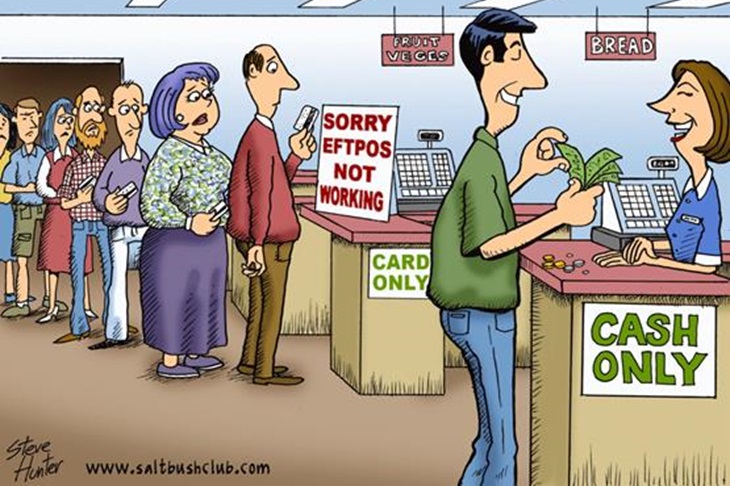Today’s world is awash with electronic money.
But a few days ago, much of Australia’s electronic money disappeared for up to 14 hours with the crash of the Optus phone network. Or at least, customer access disappeared. The disruption to business and the community was ‘immediate and profound’.
Rail networks, hospital services, retailers, and banking were affected. Naturally, this was not helped by babbling politicians waving big sticks.
Shoppers rushed to ATMs to get cash for a cup of coffee. Some were unable to pay for meals they had already consumed.
Here is a comment on the day:
Electronic money is the modern expression of a very old monetary fraud – ‘fiat money’.
‘Fiat Money’ is token currency supplied and regulated by governments and central banks. Its value relies on a government decree that it alone must be used as ‘legal tender’ in paying for anything in that country. Its value falls as its supply increases.
Fiat money is not new – Marco Polo described its use in China over 700 years ago. Travellers and traders entering China were forced by Kublai Khan to exchange their real money (gold and silver coins and bars) for his coupons, made from mulberry bark, each numbered and stamped with the Khan’s seal. The Khan decreed that local traders were forced to accept them (‘legal tender’). Foreigners got the goods, the great Khan got the bullion and the Chinese traders got the mulberry bark (a bit like getting the rough end of a pineapple). By controlling the supply and exchange rates for mulberry money, he became fabulously wealthy, and his citizens were impoverished.
But unlike electronic money accessed via Optus, mulberry money could not disappear in a flash.
The world has a long history of pretend money.
During the American War of Independence, the colonial rebels had no organised taxing power so they printed the Continental dollar to finance the war. As the war dragged on, they printed too many dollars, and its fast debasement gave rise to the phrase ‘Not worth a continental’. Later, in the American Civil War, confederate paper money used to support the army also became worthless. It was widely referred to as ‘shin-plaster’, after its highest value used in helping to bandage wounds.
Many dictators over the years tried the fiat money trick, but so many lost their heads or their thrones that it fell into disuse, being replaced by trusted real money such as English sovereigns, Spanish doubloons, Austro-Hungarian thalers, and American gold eagles. It is mainly in wartime that people are sufficiently distracted or scared to allow rulers to secretly tax everyone who holds their depreciating pretend money.
Financing Big Wars
The last century or so has seen the explosion of big governments and big wars – race wars, class wars, world wars, regional wars, the war on want, the war on drugs, the war on inflation, the war on terrorists, the war on Covid, and now the Net Zero War on carbon fuels and grazing animals.
All wars cost heaps of money. They are so expensive that to raise the full cost from honest taxes alone would cause a revolt.
The monetary watershed was the first world war, which saw governments mobilise all community resources to the war effort. Money printing plus ration cards were their main tools. Money creation destroyed currencies everywhere.
The cost of the war destroyed the German currency and the replacement papiermark was subject to the terrible German inflation of 1923 which paved the way for the rise of the Nazis.
Even the mighty pound sterling was fatally weakened by wars and the discipline of the gold/silver standard was gradually destroyed. The British gold sovereign, first minted by Henry VII in 1489, disappeared from circulation at the height of the Great War in 1917. The British pound became a fiat currency in 1931 and silver started to disappear from British and Australian currency in 1945 after the second world war. Even the mighty US dollar started on the road to ruin during the Vietnam War and gold convertibility was suspended by Richard Nixon in 1971.
We have seen the death of much of the world’s funny money in just the last 50 years. For example, in Peru, one million Intis would buy a modest home in 1985; five years later it would not buy a tube of toothpaste. Brazil had so many new banknotes they ran out of heroes to print on them.
In Vietnam in the 1980s, factories had to hire trucks to carry the bags of dongs to pay the Tet (New Year) workers’ bonuses. In 1997 in Zaire, it took a brick-sized bundle of 500,000 notes of the local currency to pay for a meal – no one bothered to count them. On the Yugoslav border in 1989, tourists foolish enough to change ‘hard’ currency for Yugoslav dinars got 14 cubic metres of dinars. ‘Dinars can no longer be measured in millions or billions, but only in cubic metres.’ It had become a cubic currency. These grim records were eclipsed in November 2008, when Zimbabwe suffered inflation of 98 per cent per day.
Most governments are good at destruction – concentration camps, gulags, dictatorships, genocide, mob rule, world wars, and … the destruction of sound money. Fiat money is their underhand method of official larceny and few people realise that the robbery is happening until it is too late.
Future generations will look back in wonder at modern monetary madness. Words like peso, rouble, rupiah, baht, won, rouble, ringgit, inti, dinar, tolar, ostmark, dong, lira, zloty, cordoba, sole, cruziero, and yuan will join ‘shin-plaster’ as descriptions of worthlessness. Most world currencies are on the same slide to oblivion (the Australian dollar has a large part of its purchasing power in the last 70 years).
‘You can’t print gold or store it in computers.’
Real money is always measurable by weight, such as pounds, grams, pennyweight ounces of gold and silver, or carats of gemstones. It cannot be counterfeited or corrupted easily.
But fiat money relies for its value on the honesty and openness of the rulers. Even a monetary fool such as Fidel Castro could see what caused Cuba’s inflation. In 1993 he stood up at a rally and declared: ‘There are 9 billion too many pesos in Cuba.’
Yesterday’s Optus money crisis in Australia is a harbinger of the future that depends on internet access to function.
But there is no safety in fleeing from Optus. To achieve ‘Net Zero’, the Green globalists plan to abolish all cash so that they can ration what we buy. ‘Sorry, you have had your sausage for November – would you like a green smoothie instead?’
The Optus shock warns us that electronic money will join Mulberry Money, Shin Plaster, and Cubic Currency in the long history of failed political money. Even our degraded paper money is better than that.
We must protect our right to have and use cash.
Got something to add? Join the discussion and comment below.
Get 10 issues for just $10
Subscribe to The Spectator Australia today for the next 10 magazine issues, plus full online access, for just $10.


























Comments
Don't miss out
Join the conversation with other Spectator Australia readers. Subscribe to leave a comment.
SUBSCRIBEAlready a subscriber? Log in